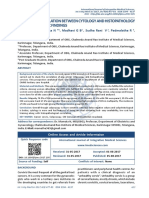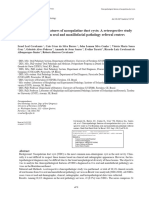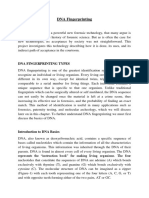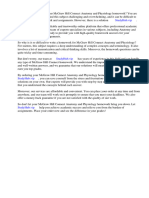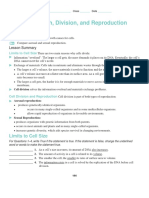Clinico-Histopathological Analysis of Orbito-Ocular Lesions: A Hospital-Based Study
Clinico-Histopathological Analysis of Orbito-Ocular Lesions: A Hospital-Based Study
Uploaded by
FKUMP17 Part 2Copyright:
Available Formats
Clinico-Histopathological Analysis of Orbito-Ocular Lesions: A Hospital-Based Study
Clinico-Histopathological Analysis of Orbito-Ocular Lesions: A Hospital-Based Study
Uploaded by
FKUMP17 Part 2Original Title
Copyright
Available Formats
Share this document
Did you find this document useful?
Is this content inappropriate?
Copyright:
Available Formats
Clinico-Histopathological Analysis of Orbito-Ocular Lesions: A Hospital-Based Study
Clinico-Histopathological Analysis of Orbito-Ocular Lesions: A Hospital-Based Study
Uploaded by
FKUMP17 Part 2Copyright:
Available Formats
General Section Original Article
Clinico-histopathological analysis of orbito-
ocular lesions: a hospital-based study
Santosh Upadhyaya Kafle1, Mrinalini Singh2, Prerna Arjyal Kafle3, Bal Kumar KC4,
Sanjeev Kumar Yadav5, Anadi Khatri KC6
1Assoc.Prof. 2Asst. Prof. Dept. of Pathology, 6Lect. Dept. of Ophthalmology, Birat
Medical College and Teaching Hospital, Morang, Nepal; 3Ophthalmologist,
Biratnagar Eye Hospital, Morang, Nepal; 4,5 Ophthalmologist, Birat Eye Hospital,
Morang, Nepal
ISSN: 2091-2749 (Print)
2091-2757 (Online)
Abstract
Correspondence Introductions: Preoperative diagnosis of orbital and ocular lesions is
Dr. Santosh Upadhyaya Kafle necessary for optimum treatment. The study aims to analyze the
Dept. of Pathology histomorphological spectrum of orbito-ocular lesions and to evaluate the
Birat Medical College and
need of ancillary techniques for confirmation of diagnosis.
Teaching Hospital
Morang, Nepal
Email: drsantoshkafle@gmail.com Methods: A cross sectional hospital based study of orbito-ocular surgical
biopsy samples obtained in the Department of Pathology, at Birat Medical
College Teaching Hospital, Nepal during one-year period was analysed for
Peer Reviewers clinical and histopathological findings. Demographic data, site and tissue
Prof. Dr. Jay N Shah type, benign or malignant, recommendations for special stains and
Patan Academy of Health immunohistochemistry panel study were analysed.
Sciences
Results: Out of 185 total samples, male to female ratio of 1.1:1, age ranged
Asst. Prof. Dr. Ashis Shrestha
from ten month to 82 years, 11-20 year age group had 39 (21.1%) orbito-
Patan Academy of Health
Sciences ocular lesions and cornea-conjunctiva was involved in 104 (56.2%). Clinical
diagnosis correlated well with histopathological diagnosis, p<0.001. The
non-neoplastic, benign and malignant lesions were 36.7%, 33.5% and
29.7% respectively. Squamous cell carcinoma was seen in 28 (50.9%) of
Submitted malignant lesions followed by sebaceous carcinoma 7 (12.7%). The special
15 Dec 2019 stains and immunohistochemistry panel was recommended in 38 (20.5%
and 21 (11.3%) cases respectively.
Accepted
28 Dec 2019
Conclusions: Findings suggest the clinical and histopathological diagnosis
correlated well in diagnosis of a wide spectrum of orbito-ocular lesions.
How to cite this article
Santosh Upadhyaya Kafle, Keywords: ancillary techniques, clincio-pathological correlation,
Mrinalini Singh, Prerna Arjyal immunohistochemistry, orbito-ocular lesions, squamous cell carcinoma
Kafle, Bal Kumar KC, Sanjeev
Kumar Yadav, Anadi Khatri KC.
Clinico-histopathological
analysis of orbito-ocular
lesions: a hospital-based study.
Journal of Patan Academy of
Health Sciences.
2019Dec;6(2):39-44.
39 Journal of Patan Academy of Health Sciences. 2019Dec;6(2):39-44.
Santosh Upadhyaya Kafle: Clinico-histological analysis of orbito-ocular lesions
Introductions correlation of clinical and histopathological
diagnosis.
The eye proves to be a unique and special
sensory organ of our body exhibiting diverse As per our hospital practice, the specimens
histologic structures. The clinical features, were fixed in 10% formalin solution. Gross
signs and symptoms related to ocular diseases examination of sample for its size, shape, color
mimic or even simulates the commonly and consistency was done. Representative
existing benign or non-neoplastic conditions areas of tissue of surgical specimens were
posing difficulties in diagnosis and treatment. sectioned and processed in an automated
There is variation in pattern and frequency due tissue processor for overnight schedule of 16-
to geographical locations.1 The variation with 18 hours. Paraffin blocks were made, trimmed
its neighbouring tissues is diagnosed by the tissue sections of 5-7 mm cut and floated
ophthalmic pathology, sub-specialty of in water bath at 45C and then taken on
pathology and ophthalmology.2 The target of albuminized slides. The slides were then
ophthalmic pathology service is to increase the examined under light microscope after
communication between the ophthalmic hematoxylin and eosin stain.
surgeon and pathologists.3
The clinical and histopathological diagnosis
The complete spectrum of orbito-ocular both were categorised into non-neoplastic and
surgical biopsies reported in literature is few neoplastic (benign, malignant) and
and rare in our part of world.3 The present descriptively analysed with MS excel and SPSS.
study analyze the histomorphological Inferential statistics (chi-square test and
spectrum with clinico-pathological correlation Spearman’s rank correlation) were used for
of orbito-ocular lesions, and the correlation between clinical and
recommendation vs actually ancillary histopathological diagnosis. The ancillary
techniques like immunohistochemistry (IHC) techniques (special stains and IHS panel)
for confirmation of diagnosis. The outcome recommendations for diagnostic confirmation
may help clinicians in planning and were correlated with histopathological
implementing the strategy for diagnosis and examination using Pearson’s chi-square test.
management in local scenario.
Results
Methods
Out of 185 orbito-ocular lesions, samples from
This was a hospital based cross-sectional study male were 98 (53%) and 39 (21.1%) were in age
of prospectively collected data for a period of group 11-20 years, Table 1. Out of 68 (36.8%)
one year during January 2017 to December non-neoplastic type, inflammatory lesions
2017 at Birat Medical College and Teaching were 35 (51.5%), followed by cystic 20 (30.3%),
Hospital, Morang, Nepal. The institutional infectious 7 (14.9%) (rhinosporidiosis five,
permission was obtained. All consecutives molluscum contagiosum and cystecercosis one
orbito-ocular surgical samples received for each) and simple descriptive report without
histopathological examination during the malignancy 6 (12.8%). Out of 117 neoplastic,
period was included. Clinical details (age, 62 (53%) were benign and 55 (47%) were
gender and site of involvement) were recorded malignant, Table 2. In ophthalmic lesions,
from the case sheets. Histopathological corneo-conjunctival were 104 (56.5%)
diagnosis, clinical profile (size of the lesion, followed by eyelid 66 (33.8%), Table 3.
past surgical history, clinical and radiological
diagnosis) and ancillary techniques (special The correlation between clinical and
stains and IHC) recommendations were histopathological diagnosis revealed strong
recorded. Data was analysed for association of positive correlation, p-value <0.001, Table 4.
demographical characteristics (age, sex) and The ancillary techniques of special stains was
40 Journal of Patan Academy of Health Sciences. 2019Dec;6(2):39-44.
Santosh Upadhyaya Kafle: Clinico-histological analysis of orbito-ocular lesions
recommended in 38 (20.5%) and IHC panel individually as benign, malignant and non-
study in 21 (11.3%) for diagnostic confirmation neoplastic variables. The correlation between
and revealed a positive correlation (p <0.001), clinical and histopathological diagnosis was
Table 4. then calculated by using Spearman’s rank
tests, revealing Spearman’s correlation ρ=
Both the clinical and histopathological 0.630, p<0.001 (significant).
diagnosis made in the study were categorized
Table 1. Demographic profile (age, sex) of orbito-ocular lesion
Age group Male (%) Female (%) N (%)
<1 1 (0.5%) 0 1 (0.5%)
1-10 10 (5.4%) 10 (5.4%) 20 (10.8%)
11-20 16 (8.6%) 23 (12.4%) 39 (21.1%)
21-30 22(11.9%) 10 (5.4%) 32 (17.3%)
31-40 13 (7.%) 15 (8.1%) 28 (15.1%)
41-50 5 (2.7%) 10 (5.4%) 15 (8.1%)
51-60 14 (7.6%) 6 (3.2%) 20 (10.8%)
61-70 11 (5.9%) 8 (4.3%) 19 (10.3%)
71-80 6 (3.2%) 4 (2.2%) 10 (5.4%)
>80 0 1 (0.5%) 1 (0.5%)
Total 98 (53%) 87 (47%) 185 (100%)
Table 2. Histologic types of neoplastic orbito-ocular lesions
Benign Lesions N (%) Malignant Lesions N (%)
Apocrine cystadenoma 1 (1.6%) Basal cell carcinoma 4 (7.3%)
Deep benign fibrous histiocytoma 1 (1.6%) Conjunctival intraepithelial neoplasia (CIN) 7 (12.7%)
Dermoid cyst 7 (11.3%) Grade I 3
Fibroma 1 (1.6%) Grade II 4
Hemangioma 7 (11.3%) Carcinoma 35 (63.6%)
Lipodermoid 8 (12.9%) Sebaceous carcinoma 7
Neurofibroma 1 (1.6%) Squamous cell carcinoma in situ (SCCIS) 12
Nevus 17 (27.4%) Squamous cell carcinoma 16
Compound nevus 6 Melanoma 3 (5.4%)
Epidermal nevus 1 Conjunctival 2
Intradermal nevus 9 Choroidal 1
Spindle cell nevus 1 Lympho proliferative disorder 1 (1.8%)
Ocular Melanocytosis 1 (1.6%) Lymphoma Non-Hodgkins 4 (7.3%)
Pyogenic granuloma 9 (14.5%) Retinoblastoma 1 (1.8%)
Sebaceous adenoma 1 (1.6%)
Seborrhoeic keratosis 2 (3.2%)
Squamous cell papilloma 2 (3.2%)
Syringocystadenoma papilliferum 1 (1.6%)
Verruca keratosis 2 (3.2%)
Verruca vulgaris 1 (1.6%)
Total 62 (100%) Total 55 (100%)
Table 3. Prevalence of different Corneal & Conjunctival and Eyelid lesions
41 Journal of Patan Academy of Health Sciences. 2019Dec;6(2):39-44.
Santosh Upadhyaya Kafle: Clinico-histological analysis of orbito-ocular lesions
Corneal & Conjunctival lesions N (%) Eyelid lesions N (%)
Granulomatous inflammation 19 (18.3%) Granulomatous inflammation 07 (10.6%)
Cyst 17 (16.3%) Nevus 05 (7.6%)
Squamous cell carcinoma in situ 12 (11.5%) Sebaceous carcinoma 04 (6.1%)
Squamous cell carcinoma 11 (10.6%) Cyst 03 (4.5%)
Lipodermoid 06 (5.8%) Pyogenic granuloma 03 (4.5%)
Nevus 05 (4.8%) Hemangioma 03 (4.5%)
Pyogenic granuloma 05 (4.8%) Rhinospordiosis 02 (3%)
Descriptive (Benign) 04 (3.8%) Basal cell carcinoma 01 (1.5%)
Conjunctival intraepithelial neoplasia
04 (3.8%) Descriptive 01 (1.5%)
Grade II
Conjunctival intraepithelial neoplasia
03 (2.9%) Squamous cell carcinoma 01 (1.5%)
Grade I
Calcinosis 03 (2.9%) Seborrhoeic keratosis 07 (10.6%)
Rhinosporiodiosis 02 (1.9%) Rosai Dorfman disease 05 (7.6%)
Hemangioma 02 (1.9%) Syringocyst adenoma papilleferum 04 (6.1%)
Melanoma 02 (1.9%) Verruca vulgaris 01 (1.5%)
Non-Hodgkins Lymphoma 02 (1.9%) Lymphoma 01 (1.5%)
Molluscum contagiosum 01 (1%) Verrucoid keratosis 01 (1.5%)
Apocrine cystadenoma 01 (1%) Deep benign fibrous histiocytoma 01 (1.5%)
Squamous cell papilloma 01 (1%) Squamous papilloma 01 (1.5%)
Cysticercosis 01 (1%)
Fibroma 01 (1%)
Basal cell carcinoma 01 (1%)
Lymphoproliferative lesion 01 (1%)
Total 104 (100%) 66 (100%)
Table 4. Cross tabulation between recommendations made with the histopathological examinations (using
Pearson’s chi-square tests)
Recommendations p
No IHC Special stain
Histopathologic No 43 (86.0%) 5 (10.0%) 2 (4.0%)
examination IHC 40 (70.2%) 15 (26.3%) 2 (3.5%)
<0.001*
Special Stain 42 (53.8%) 2 (2.6%) 34 (43.6%)
Total 125 (67.6%) 22 (11.9%) 38 (20.5%)
IHC= immunohistochemistry, *the test result is significant at p<0.05
Discussions similar to reported male preponderance (11%)
in 21-30 year age group but different in female
Out of 185 orbito-ocular lesions, highest showing higher (10%) in age group of 31-40
incidence of 39 (21.1%) were found in 11-20 and 41-50 years.3
year age group, and bimodal appearance with
lowest incidence in less than one year and We found 68 (36.76%) non-neoplastic unlike
above 80 years. This in contrast to the highest the reported higher incidence of non-
incidence in 0-9 years4 and 31-40 years2 and neoplastic lesions in the literature.4 This was
lowest in the age group of 81-90 years3. probably due to the high incidence of
rhinosporidiosis infection, 81 (31%) in their
Our findings of slightly higher (53%) study. The prevalence of eighty-two ocular
involvement in males than females (47%) has rhinosporidiosis in Eastern Nepal is reported5,
been reported in literature with 50.4% males which was claimed as being first to document
and 49.6% females respectively.3 Also we and report such kind in Nepal.
found, male preponderance (11.9%) in 21-30
age group and female (12.5%) in 11-20 years,
42 Journal of Patan Academy of Health Sciences. 2019Dec;6(2):39-44.
Santosh Upadhyaya Kafle: Clinico-histological analysis of orbito-ocular lesions
The benign neoplastic lesions were more commonest lesion followed by epidermal
common 62 (54.4%) in our study, similar to inclusion cysts (14%) and intradermal nevus
other studies with more benign lesions (12.2%). The basal cell carcinoma (4.5%) was in
(70%).2,3 However, higher incidence of the highest number for malignant eyelid
malignant lesions has been reported in lesions in our study, similar to others.13,14
literature.4,6,7 Our study showed the Besides, few rare diseases like Rosai Dorfman
melanocytic nevus (27.4%) was highest disease, Syringocystadenoma papilleferum
number followed by benign vascular tumors, and deep benign fibrous histiocytoma were
hemangioma and pyogenic granuloma. Nevus seen as eyelid lesions in our study.
being most common (70%) among benign
neoplastic lesion was also reported in other The clinical diagnosis was consistent with the
study.8 histopathological diagnosis in 120 (65%) cases
in our study, slightly less than reported findings
We found squamous cell carcinoma being of 84%, 91.5% and 96% respectively.15-17
most common malignancy followed by
sebaceous carcinoma, Table 2 and 3. This is in Our study revealed the ancillary techniques
contrast to report of retinoblastoma being the recommendation for special stains in 38
most common malignant neoplasm followed (20.5%) and immunohistochemistry (IHC)
by sebaceous carcinoma and squamous cell panel in 22 (11.3%) for further confirmation,
carcinoma.4 In a series from Pakistan6, had a positive correlation (p<0.001), Table 4.
retinoblastoma was the commonest lesion This supports the need of ancillary techniques
followed by squamous cell carcinoma of for special stains and IHC panel study for the
conjunctiva and basal cell carcinoma. specific as well confirmatory diagnosis and
Differently, basal cell carcinoma was the signifies the importance of ancillary techniques
commonest malignant neoplastic lesion together with. At our center, we receive biopsy
followed by squamous cell carcinoma and specimens from the different eye hospitals in
melanoma respectively in another study.8 Yet the region, and may and may be taken as
another study reports squamous cell representative sample of the distribution of
carcinoma as the commonest being 33.5%.10 orbito-ocular lesions from the eastern part of
The findings of retinoblastoma in our study our country.
was low, similar others study from Nepal.1 In
contrast, a high percentage of malignant The limitations of our study include the wide
orbito-ocular lesions, retinoblastoma variation and small numbers in some of the
constituting 40.1%, 31.7% and 32% have been spectrum of orbito-ocular lesions. With lack of
reported.4,10,11 published data from this region, it was difficult
to provide comparison.
We found conjunctiva lesion being the most
common (56.2%) followed by the eyelid
(35.7%) similar to the other series.1,9 Among Conclusions
the malignant corneo-conjunctival lesions, the
squamous cell carcinoma (11.5%) including Our findings reveal positive correlation
squamous cell carcinoma in situ (16.3%) was between the clinical and histopathological
commonest in our study, similar to other diagnosis of orbito-ocular lesions.
studies.1,2,12 Inflammatory lesions accounted for half of the
non-neoplastic lesion, squamous cell
Regarding the distribution of the orbito-ocular carcinoma were 2/3rd of malignant neoplasm.
lesions within eyelid regions in our study, the Granulomatous inflammatory lesions were
granulomatous inflammation (19.7%) was the commonest within the corneo-conjuctiva and
commonest followed by nevus (16.7%), and eyelid lesions.
vascular tumors (13.7%). Another study from
Nepal3 reports dermoid cysts (21%) being
Acknowledgements
43 Journal of Patan Academy of Health Sciences. 2019Dec;6(2):39-44.
Santosh Upadhyaya Kafle: Clinico-histological analysis of orbito-ocular lesions
7. Charles NC, James EV. A study of the
We are thankful to Dr. Tara Kafle for her histopathologic pattern of orbito-ocular
support in statistical analysis. disease in a tertiary hospital in Nigeria. Sahel
Medical Journal. 2014;17(2):60-64. DOI
GoogleScholar
8. Kapurdov A, Kapurdova M. Clinical,
Conflict of interests morphological and epidemiological data on
eye tumors. Trakia J Sci. 2010;8(4):34-9.
None GoogleScholar Weblink
9. Obata H, Aoki Y, Kubota S, Kanai N, Tsuru T.
Incidence of benign and malignant lesions of
Funding eyelid and conjunctival tumors [article in
Japanese]. Nippon Ganka Gakkai Zasshi.
None 2005;109(9):573-9. PubMed GoogleScholar
10. Poso MY, Mwanza JC, Kayembe DL. Malignant
tumours of the eye and adnexa in Congo-
Kinshasa [article in French]. J Fr Ophthalmol.
References 2000;23(4):327-32. PubMed GoogleScholar
11. Sunderraj P. Malignant tumours of the eye
1. Kumar R, Adhikari RK, Sharma MK, Pokharel and adnexa. Indian J Ophthalmol.
DR, Gautam N. Pattern of ocular malignant 1991;39(1):6-8. PubMed GoogleScholar
tumors in Bhairahwa, Nepal. The Internet 12. Mondal SK, Nag DR, Bandyopadhyay R,
Journal of Ophthalmology and Visual Science. Adhikari A, Mukhopadhyay S. Conjunctival
2009;7(1). GoogleScholar Weblink biopsies and ophthalmic lesions: a
2. Chauhan SC, Shah SJ, Patel AB, Rathod HK, histopathologic study in eastern India. J Res
Surve SD, Nasit JG. A histopathological study Med Sci. 2012;17(12):1176-9. PubMed
of ophthalmic lesions at a teaching hospital. GoogleScholar
Nat’l J Med Res. 2012;2(2):133-6. Weblink 13. Tesluk GC. Eyelid lesions: incidence and
3. Bastola P, Koirala S, Pokhrel G, Ghimire P, comparison of benign and malignant lesions.
Adhikari RK. A clinico-histopathological study Ann Ophthalmol. 1985;17(11):704-7. PubMed
of orbital and ocular lesions; a multicenter GoogleScholar
study. Journal of Chitwan Medical College. 14. Abdi U, Tyagi N, Maheshwari V, Gogi R, Tyagi
2013;3(2):40-4. DOI GoogleScholar SP. Tumours of eyelid: a clinicopathologic
4. Gupta Y, Gahine R, Hussain N, Memom MJ. study. J Indian Med Assoc. 1996;94(11):405-
Clinico-pathological spectrum of ophthalmic 9,16,18. PubMed GoogleScholar
lesions: an experience in tertiary care hospital 15. Kersten RC, Ewing-Chow D, Kulwin DR, Gallon
of central India. J Clin Diagn Res. M. Accuracy of clinical diagnosis of cutaneous
2017;11(1):EC09-13. DOI PubMed eyelid lesions. Ophthalmology.
GoogleScholar 1997;104(3):479-84. DOI PubMed
5. Shrestha SP, Hening A, Parija SC. Prevalence of GoogleScholar
rhinosporidiosis of the eye and its adnexa in 16. Deokule S, Child V, Tarin S, Sandramouli S.
Nepal. Am J Trop Med Hyg. 1998;59(2):231-4. Diagnostic accuracy of benign eyelid skin
DOI PubMed GoogleScholar lesions in the minor operation theatre. Orbit.
6. Ud-Din N, Mushtaq S, Mamoon N, Khan AH, 2003;22(4):235-8. DOI PubMed GoogleScholar
Malik IA. Morphological spectrum of 17. Margo CE. Eyelid tumors: accuracy of clinical
ophthalmic tumors in northern Pakistan. J Pak diagnosis. Am J Ophthalmol. 1999;128(5):635-
Med Assoc. 2001;51(1):19-22. PubMed 6. DOI PubMed GoogleScholar
GoogleScholar Weblink
44 Journal of Patan Academy of Health Sciences. 2019Dec;6(2):39-44.
You might also like
- Answers To End-Of-Chapter Questions Chapter 7: Animal Nutrition100% (1)Answers To End-Of-Chapter Questions Chapter 7: Animal Nutrition2 pages
- The Diagnostic Criteria For Chronic EndometritisNo ratings yetThe Diagnostic Criteria For Chronic Endometritis7 pages
- Clinical Characteristics and Surgical Outcomes in Patients With Intermittent ExotropiaNo ratings yetClinical Characteristics and Surgical Outcomes in Patients With Intermittent Exotropia6 pages
- Clinical Outcomes in A Specialist Male Genital Skin Clinic: Prospective Follow-Up of 600 PatientsNo ratings yetClinical Outcomes in A Specialist Male Genital Skin Clinic: Prospective Follow-Up of 600 Patients5 pages
- Cytology of Bone Fine Needle Aspiration BiopsyNo ratings yetCytology of Bone Fine Needle Aspiration Biopsy11 pages
- Dermoscopy To Differentiate Guttate Psoriasis From A MimickerNo ratings yetDermoscopy To Differentiate Guttate Psoriasis From A Mimicker6 pages
- Clinicopathological Comparison of Periapical CystNo ratings yetClinicopathological Comparison of Periapical Cyst5 pages
- Original Article: The Diagnostic Accuracy of Fine Needle Aspiration Cytology in Neck Lymphoid MassesNo ratings yetOriginal Article: The Diagnostic Accuracy of Fine Needle Aspiration Cytology in Neck Lymphoid Masses4 pages
- Evaluationoforalcavitypathologiesinpediatricdentistrypatients.A10yearretrospectivestudyNo ratings yetEvaluationoforalcavitypathologiesinpediatricdentistrypatients.A10yearretrospectivestudy7 pages
- 9p21 Loss Detected by FISH Is Associated With - 2013 - Journal of The American ANo ratings yet9p21 Loss Detected by FISH Is Associated With - 2013 - Journal of The American A1 page
- Dental Panoramic Radiographic Evaluation in Bisphosphonate-Associated Osteonecrosis of The JawsNo ratings yetDental Panoramic Radiographic Evaluation in Bisphosphonate-Associated Osteonecrosis of The Jaws1 page
- International Journal of Scientific Research: Radio-DiagnosisNo ratings yetInternational Journal of Scientific Research: Radio-Diagnosis2 pages
- August 2003: East African Medical Journal 411No ratings yetAugust 2003: East African Medical Journal 4114 pages
- A Clinico-Pathological Study of Thyroid Nodules and Correlation Among Ultrasonographic, Cytologic, and Histologic FindingsNo ratings yetA Clinico-Pathological Study of Thyroid Nodules and Correlation Among Ultrasonographic, Cytologic, and Histologic Findings8 pages
- Histologic Findings of Tonsillectomy Specimen With The Necessity of Microscopic Evaluation in Young PatientNo ratings yetHistologic Findings of Tonsillectomy Specimen With The Necessity of Microscopic Evaluation in Young Patient4 pages
- Clinical Features and Visual Outcomes of Optic Neuritis in Chinese ChildrenNo ratings yetClinical Features and Visual Outcomes of Optic Neuritis in Chinese Children7 pages
- Can Inflammatory Index Parameters Be An IndicatorNo ratings yetCan Inflammatory Index Parameters Be An Indicator9 pages
- 291 Do Clinical-Pathological Communication and Correlation Influence The Diagnosis and Incidence of Osteonecrosis?No ratings yet291 Do Clinical-Pathological Communication and Correlation Influence The Diagnosis and Incidence of Osteonecrosis?1 page
- Optic Nerve Glioma: Case Series With Review of Clinical, Radiologic, Molecular, and Histopathologic CharacteristicsNo ratings yetOptic Nerve Glioma: Case Series With Review of Clinical, Radiologic, Molecular, and Histopathologic Characteristics5 pages
- SPECTCT Correlation in the Diagnosis of UnilateralNo ratings yetSPECTCT Correlation in the Diagnosis of Unilateral13 pages
- Acta Ophthalmologica - 2016 - Li - Prevalence and Associations of Central Serous Chorioretinopathy in Elderly Chinese TheNo ratings yetActa Ophthalmologica - 2016 - Li - Prevalence and Associations of Central Serous Chorioretinopathy in Elderly Chinese The5 pages
- Oral_squamous_cell_carcinoma_A_5_years_institutionNo ratings yetOral_squamous_cell_carcinoma_A_5_years_institution5 pages
- Fine Needle Aspiration Cytology in Breast Lump - Its Cytological Spectrum and Statistical Correlation With HistopathologyNo ratings yetFine Needle Aspiration Cytology in Breast Lump - Its Cytological Spectrum and Statistical Correlation With Histopathology10 pages
- Radiological and Cytological Correlation of Breast Lesions With Histopathological Findings in A Tertiary Care Hospital in Costal KarnatakaNo ratings yetRadiological and Cytological Correlation of Breast Lesions With Histopathological Findings in A Tertiary Care Hospital in Costal Karnataka4 pages
- Prevalence and Profi Le of Central Serous Chorioretinopathy in An Indian CohortNo ratings yetPrevalence and Profi Le of Central Serous Chorioretinopathy in An Indian Cohort6 pages
- Anorectal Malformations in A Tertiary Pediatric Surgery Center Fromromania 20 Years of Experience 1584 9341-12-2 3No ratings yetAnorectal Malformations in A Tertiary Pediatric Surgery Center Fromromania 20 Years of Experience 1584 9341-12-2 35 pages
- Malignant External Otitis: Factors Predicting Patient OutcomesNo ratings yetMalignant External Otitis: Factors Predicting Patient Outcomes6 pages
- Anatomical Study of Canthal Index: The Morphometrical StudyNo ratings yetAnatomical Study of Canthal Index: The Morphometrical Study5 pages
- Ophthalmic Manifestations of Paederus DermatitisNo ratings yetOphthalmic Manifestations of Paederus Dermatitis7 pages
- Clinical Indications for Repeat MRI in Children With Acute Hematogenous OsteomyelitisNo ratings yetClinical Indications for Repeat MRI in Children With Acute Hematogenous Osteomyelitis5 pages
- Neoadjuvant Systemic Chemotherapy in Sebaceous Gland Carcinoma of The Eyelid: A Retrospective StudyNo ratings yetNeoadjuvant Systemic Chemotherapy in Sebaceous Gland Carcinoma of The Eyelid: A Retrospective Study6 pages
- International Journal of International Journal of International Journal ofNo ratings yetInternational Journal of International Journal of International Journal of6 pages
- Research Article: Clinical Profile and Visual Outcome of Ocular Bartonellosis in MalaysiaNo ratings yetResearch Article: Clinical Profile and Visual Outcome of Ocular Bartonellosis in Malaysia7 pages
- Diagnostic Problems in Tumors of Central Nervous System: Selected TopicsFrom EverandDiagnostic Problems in Tumors of Central Nervous System: Selected TopicsNo ratings yet
- Diagnostic Problems in Tumors of Head and Neck: Selected Topics: DIAGNOSTIC PROBLEMS IN TUMOR PATHOLOGY SERIES, #1From EverandDiagnostic Problems in Tumors of Head and Neck: Selected Topics: DIAGNOSTIC PROBLEMS IN TUMOR PATHOLOGY SERIES, #15/5 (1)
- 1.1.3 Study - Applied Science and Technology (Study Guide)No ratings yet1.1.3 Study - Applied Science and Technology (Study Guide)18 pages
- Mcgraw Hill Connect Anatomy and Physiology Homework Answers100% (1)Mcgraw Hill Connect Anatomy and Physiology Homework Answers5 pages
- Distrofia Granulo-Vacuolara Renala (Intumescenta Tulbure Renala)No ratings yetDistrofia Granulo-Vacuolara Renala (Intumescenta Tulbure Renala)8 pages
- Introduction To Infectious Diseases FinalNo ratings yetIntroduction To Infectious Diseases Final67 pages
- Gender Identity and Expression in The Workplace - A Pragmatic Guide For Lawyers and Human Resource ProfessionalsNo ratings yetGender Identity and Expression in The Workplace - A Pragmatic Guide For Lawyers and Human Resource Professionals71 pages
- A Deep Learning Approach To Antibiotic DiscoveryNo ratings yetA Deep Learning Approach To Antibiotic Discovery29 pages
- Cell Growth, Division, and Reproduction: Limits To Cell Size100% (1)Cell Growth, Division, and Reproduction: Limits To Cell Size2 pages
- MCQ 1 General Introduction and PharmacokineticsNo ratings yetMCQ 1 General Introduction and Pharmacokinetics7 pages
- Dbt-Twas Biotechnology Fellowships in IndiaNo ratings yetDbt-Twas Biotechnology Fellowships in India23 pages
- Answers To End-Of-Chapter Questions Chapter 7: Animal NutritionAnswers To End-Of-Chapter Questions Chapter 7: Animal Nutrition
- Clinical Characteristics and Surgical Outcomes in Patients With Intermittent ExotropiaClinical Characteristics and Surgical Outcomes in Patients With Intermittent Exotropia
- Clinical Outcomes in A Specialist Male Genital Skin Clinic: Prospective Follow-Up of 600 PatientsClinical Outcomes in A Specialist Male Genital Skin Clinic: Prospective Follow-Up of 600 Patients
- Dermoscopy To Differentiate Guttate Psoriasis From A MimickerDermoscopy To Differentiate Guttate Psoriasis From A Mimicker
- Original Article: The Diagnostic Accuracy of Fine Needle Aspiration Cytology in Neck Lymphoid MassesOriginal Article: The Diagnostic Accuracy of Fine Needle Aspiration Cytology in Neck Lymphoid Masses
- Evaluationoforalcavitypathologiesinpediatricdentistrypatients.A10yearretrospectivestudyEvaluationoforalcavitypathologiesinpediatricdentistrypatients.A10yearretrospectivestudy
- 9p21 Loss Detected by FISH Is Associated With - 2013 - Journal of The American A9p21 Loss Detected by FISH Is Associated With - 2013 - Journal of The American A
- Dental Panoramic Radiographic Evaluation in Bisphosphonate-Associated Osteonecrosis of The JawsDental Panoramic Radiographic Evaluation in Bisphosphonate-Associated Osteonecrosis of The Jaws
- International Journal of Scientific Research: Radio-DiagnosisInternational Journal of Scientific Research: Radio-Diagnosis
- A Clinico-Pathological Study of Thyroid Nodules and Correlation Among Ultrasonographic, Cytologic, and Histologic FindingsA Clinico-Pathological Study of Thyroid Nodules and Correlation Among Ultrasonographic, Cytologic, and Histologic Findings
- Histologic Findings of Tonsillectomy Specimen With The Necessity of Microscopic Evaluation in Young PatientHistologic Findings of Tonsillectomy Specimen With The Necessity of Microscopic Evaluation in Young Patient
- Clinical Features and Visual Outcomes of Optic Neuritis in Chinese ChildrenClinical Features and Visual Outcomes of Optic Neuritis in Chinese Children
- 291 Do Clinical-Pathological Communication and Correlation Influence The Diagnosis and Incidence of Osteonecrosis?291 Do Clinical-Pathological Communication and Correlation Influence The Diagnosis and Incidence of Osteonecrosis?
- Optic Nerve Glioma: Case Series With Review of Clinical, Radiologic, Molecular, and Histopathologic CharacteristicsOptic Nerve Glioma: Case Series With Review of Clinical, Radiologic, Molecular, and Histopathologic Characteristics
- SPECTCT Correlation in the Diagnosis of UnilateralSPECTCT Correlation in the Diagnosis of Unilateral
- Acta Ophthalmologica - 2016 - Li - Prevalence and Associations of Central Serous Chorioretinopathy in Elderly Chinese TheActa Ophthalmologica - 2016 - Li - Prevalence and Associations of Central Serous Chorioretinopathy in Elderly Chinese The
- Oral_squamous_cell_carcinoma_A_5_years_institutionOral_squamous_cell_carcinoma_A_5_years_institution
- Fine Needle Aspiration Cytology in Breast Lump - Its Cytological Spectrum and Statistical Correlation With HistopathologyFine Needle Aspiration Cytology in Breast Lump - Its Cytological Spectrum and Statistical Correlation With Histopathology
- Radiological and Cytological Correlation of Breast Lesions With Histopathological Findings in A Tertiary Care Hospital in Costal KarnatakaRadiological and Cytological Correlation of Breast Lesions With Histopathological Findings in A Tertiary Care Hospital in Costal Karnataka
- Prevalence and Profi Le of Central Serous Chorioretinopathy in An Indian CohortPrevalence and Profi Le of Central Serous Chorioretinopathy in An Indian Cohort
- Anorectal Malformations in A Tertiary Pediatric Surgery Center Fromromania 20 Years of Experience 1584 9341-12-2 3Anorectal Malformations in A Tertiary Pediatric Surgery Center Fromromania 20 Years of Experience 1584 9341-12-2 3
- Malignant External Otitis: Factors Predicting Patient OutcomesMalignant External Otitis: Factors Predicting Patient Outcomes
- Anatomical Study of Canthal Index: The Morphometrical StudyAnatomical Study of Canthal Index: The Morphometrical Study
- Clinical Indications for Repeat MRI in Children With Acute Hematogenous OsteomyelitisClinical Indications for Repeat MRI in Children With Acute Hematogenous Osteomyelitis
- Neoadjuvant Systemic Chemotherapy in Sebaceous Gland Carcinoma of The Eyelid: A Retrospective StudyNeoadjuvant Systemic Chemotherapy in Sebaceous Gland Carcinoma of The Eyelid: A Retrospective Study
- International Journal of International Journal of International Journal ofInternational Journal of International Journal of International Journal of
- Research Article: Clinical Profile and Visual Outcome of Ocular Bartonellosis in MalaysiaResearch Article: Clinical Profile and Visual Outcome of Ocular Bartonellosis in Malaysia
- Diagnostic Problems in Tumors of Central Nervous System: Selected TopicsFrom EverandDiagnostic Problems in Tumors of Central Nervous System: Selected Topics
- Diagnostic Problems in Tumors of Head and Neck: Selected Topics: DIAGNOSTIC PROBLEMS IN TUMOR PATHOLOGY SERIES, #1From EverandDiagnostic Problems in Tumors of Head and Neck: Selected Topics: DIAGNOSTIC PROBLEMS IN TUMOR PATHOLOGY SERIES, #1
- 1.1.3 Study - Applied Science and Technology (Study Guide)1.1.3 Study - Applied Science and Technology (Study Guide)
- Mcgraw Hill Connect Anatomy and Physiology Homework AnswersMcgraw Hill Connect Anatomy and Physiology Homework Answers
- Distrofia Granulo-Vacuolara Renala (Intumescenta Tulbure Renala)Distrofia Granulo-Vacuolara Renala (Intumescenta Tulbure Renala)
- Gender Identity and Expression in The Workplace - A Pragmatic Guide For Lawyers and Human Resource ProfessionalsGender Identity and Expression in The Workplace - A Pragmatic Guide For Lawyers and Human Resource Professionals
- Cell Growth, Division, and Reproduction: Limits To Cell SizeCell Growth, Division, and Reproduction: Limits To Cell Size










